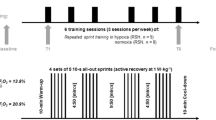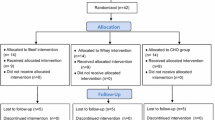Abstract
Purpose
The primary aim of this study was to determine the levels of salivary secretory IgA (sIgA) and salivary alpha-amylase (sAA) in young, black male soccer players, before and after 12 weeks of soccer-specific training.
Methods
Thirty-four children (11–13 years) who were part of a youth soccer development training academy, participated in the study. The participants underwent 12 weeks of soccer-specific training. Resting saliva samples were collected 48 h before the commencement, and 48 h after the completion, of the training program. Samples were taken between 07:30 and 08:30, 90 min after waking. Body fat percentage (BF %), lean body mass (LBM) and cardiorespiratory fitness (CRF) were also measured.
Results
Significant differences were found between pre- and post-training for body mass index (BMI) (P < 0.05), waist-to-hip ratio (P < 0.05), height (P < 0.0001), BF % (P < 0.0001) and LBM (P < 0.0001). sIgA secretion rate increased significantly from pre- to post-training (P < 0.05) however, no significant differences were found in sAA concentration (P > 0.05), sAA secretion rate (P > 0.05) or sIgA concentration (P > 0.05). The magnitude of differences from pre- to post-training applying Cohen’s d effect sizes (ES) were moderate (>0.5) for estimated VO2max, sAA, sAA secretion rate, sIgA and sIgA secretion rate.
Conclusion
These findings suggest that, 12 weeks of soccer-specific training enhances mucosal immunity and body composition and may have an effect on the sympathetic nervous system in black, male youths.
Similar content being viewed by others
Abbreviations
- BF %:
-
Body fat percentage
- BMI:
-
Body mass index
- BW:
-
Body weight
- BF:
-
Body fat
- CI:
-
Confidence intervals
- CRF:
-
Cardiorespiratory fitness
- CV:
-
Coefficients of variation
- ES:
-
Effect sizes
- LBM:
-
Lean body mass
- PA:
-
Physical activity
- Saa:
-
Salivary alpha-amylase
- sIgA:
-
Salivary IgA
- SNS:
-
Sympathetic nervous system
- pIgR:
-
Polymeric immunoglobulin receptor
- URTI:
-
Upper respiratory tract infection
- VO2max :
-
Maximal aerobic capacity
References
Bangsbo J (1993) The physiology of soccer—with special reference to intense intermittent exercise. Acta Physiol Scand Suppl 619:1–155
Stølen T, Chamari K, Castagna C, Wisløff U (2005) Physiology of soccer: an update. Sports Med 35(6):501–536
Blatter J, Dvorak J (2014) Football for Health-Science proves that playing football on a regular basis contributes to the improvement of public health. Scand J Med Sci Sports 24(S1):2–3
Krustrup P, Dvorak J, Junge A, Bangsbo J (2010) Executive summary: the health and fitness benefits of regular participation in small-sided football games. Scand J Med Sci Sports 20(s1):132–135
Vasconcellos F, Seabra A, Cunha F, Montenegro R, Penha J, Bouskela E, Nogueira Neto JF, Collett-Solberg P, Farinatti P (2015) Health markers in obese adolescents improved by a 12-week recreational soccer program: a randomised controlled trial. J Sports Sci (ahead-of-print):1–12
Gleeson M, Pyne DB, Callister R (2004) The missing links in exercise effects on mucosal immunity. Exerc Immunol Rev 10 (10)
Sari-Sarraf V, Reilly T, Doran DA, Atkinson G (2007) The effects of single and repeated bouts of soccer-specific exercise on salivary IgA. Arch Oral Biol 52(6):526–532
Sari-Sarraf V, Reilly T, Doran D, Atkinson G (2008) Effects of repeated bouts of soccer-specific intermittent exercise on salivary IgA. Int J Sports Med 29(5):366–371
Filaire E, Bonis J, Lac G (2004) Relationships between physiological and psychological stress and salivary immunoglobulin A among young female gymnasts. Percept Mot Skills 99(2):605–617
Nieman DC, Kernodle MW, Henson DA, Sonnenfeld G, Morton DS (2000) The acute response of the immune system to tennis drills in adolescent athletes. Res Q Exerc Sport 71(4):403–408
Tharp GD (1991) Basketball exercise and secretory immunoglobulin A. Eur J Appl Physiol Occup Physiol 63(3–4):312–314
Dorrington M, Gleeson M, Callister R (2003) Effect of exercise intensity on salivary IgA in children. J Sci Med Sport 6:46
Thomas NE, Leyshon A, Hughes MG, Davies B, Graham M, Baker JS (2009) The effect of anaerobic exercise on salivary cortisol, testosterone and immunoglobulin (A) in boys aged 15–16 years. Eur J Appl Physiol 107(4):455–461
Christensen NJ, Galbo H (1983) Sympathetic nervous activity during exercise. Annu Rev Physiol 45(1):139–153
Nater U, Rohleder N (2009) Salivary alpha-amylase as a non-invasive biomarker for the sympathetic nervous system: current state of research. Psychoneuroendocrinology 34:486–496
Granger D, Kivlighan K, Blair C, El-Sheikh M, Mize J, Lisonbee J, Buckhalt J, Stroud L, Handwerger K, Schwartz E (2006) Integrating the measurement of salivary alpha amylase into studies of child health, development, and social relationships. J Soc Pers Relatsh 23:267–290
Ljungberg G, Ericson T, Ekblom B, Birkhed D (1997) Saliva and marathon running. Scand J Med Sci Sports 7:214–219
Chatterton R, Vogelsong K, Lu Y, Ellman A, Hudgens G (1996) Salivary alpha-amylase as a measure of endogenous adrenergic activity. Clin Physiol 16:433–448
Steerenberg P, van Asperen I, Van Nieuw Amerongen A, Biewenga J, Mol D, Medema G (1997) Salivary levels of immunoglobulin A in triathletes Eur J Oral Sci 105:305–309
Walsh N, Blannin A, Clark A, Cook L, Robson P, Gleeson M (1999) The effects of high-intensity intermittent exercise on saliva IgA, total protein and alpha-amylase. J Sports Sci 17:129–134
Nexø E, Hansen M, Konradsen L (1988) Human salivary epidermal growth factor, haptocorrin and amylase before and after prolonged exercise. Scand J Clin Lab Invest 48(3):269–273
Chicharro JL, Pérez M, Carvajal A, Bandrés F, Lucía A (1999) The salivary amylase, lactate and electromyographic response to exercise. Jpn J Physiol 49(6):551–554
Li T, Gleeson M (2004) The effect of single and repeated bouts of prolonged cycling and circadian variation on saliva flow rate, immunoglobulin A and-amylase responses. J Sports Sci 22(11–12):1015–1024
Capranica L, Lupo C, Cortis C, Chiodo S, Cibelli G, Tessitore A (2012) Salivary cortisol and alpha-amylase reactivity to taekwondo competition in children. Eur J Appl Physiol 112(2):647–652
Takai N, Yamaguchi M, Aragaki T, Eto K, Uchihashi K, Nishikawa Y (2004) Effect of psychological stress on the salivary cortisol and amylase levels in healthy young adults. Arch Oral Biol 49(12):963–968
Salimetrics (2010) Improving saliva study results. https://www.salimetrics.com/newsletter-v1/November-2010
Brook C (1971) Determination of body composition of children from skinfold measurements. Arch Dis Child 46:182–184
Isasi C, Deckelbaum R, Tracy R, Starc T, Berglund L, Shea S (2003) Physical fitness and C-reactive protein level in children and young adults: the Columbia University Biomarkers Study. Pediatrics 111(2):332–338
Ledger L, Lambert J (1982) A maximal. Multistage 20-m shuttle run test to predict VO2max. Eur J Appl Physiol 49:1–12
Tomkinson GR, Léger LA, Olds TS, Cazorla G (2003) Secular trends in the performance of children and adolescents (1980–2000): an analysis of 55 studies of the 20 m shuttle run test in 11 countries. Sports Med 33(4):285–300
Hopkins W, Marshall S, Batterham A (2009) Progressive statistics for studies in sports medicine and exercise science. Med Sci Sports Exerc 41:3–12
Chamari K, Hachana Y, Kaouech F, Jeddi R, Moussa-Chamari I, Wisløff U (2005) Endurance training and testing with the ball in young elite soccer players. Br J Sports Med 39:24–28
Chamari K, Moussa-Chamari I, Boussaïdi L, Hachana Y, Kaouech F, Wisløff U (2005) Appropriate interpretation of aerobic capacity: allometric scaling in adult and young soccer players. Br J Sports Med 39:97–101
Bunc V, Psotta R (2001) Physiological profile of very young soccer players. J Sports Med Phys Fitness 41(3):337–341
Cohen S, Doyle WJ, Baum A (2006) Socioeconomic status is associated with stress hormones. Psychosom Med 68(3):414–420
Dignan M (2001) Socioeconomic status and health in industrial nations: social psychological and biological pathways. Psychosom Med 63(2):329–330
Miller JE, Korenman S (1994) Poverty and children’s nutritional status in the United States. Am J Epidemiol 140(3):233–243
Krustrup P, Nielsen JJ, Krustrup BR, Christensen JF, Pedersen H, Randers MB, Aagaard P, Petersen A-M, Nybo L, Bangsbo J (2009) Recreational soccer is an effective health-promoting activity for untrained men. Br J Sports Med 43(11):825–831
Reilly T, Bangsbo J, Franks A (2000) Anthropometric and physiological predispositions for elite soccer. J Sports Sci 18(9):669–683
Lavie CJ, Milani RV, Ventura HO (2009) Obesity and cardiovascular disease: risk factor, paradox, and impact of weight loss. J Am Coll Cardiol 53(21):1925–1932
Janeway CA, Travers P, Walport M, Shlomchik MJ (2001) Immunobiology: the immune system in health and disease, vol 2. Churchill Livingstone, London
Lamm M (1997) Interaction of antigens and antibodies at mucosal surfaces. Annu Rev Microbiol 51:311–340
Salvi S, Holgate S (1999) Could the airway epithelium play an important role in mucosal immunoglobin A production. Clin Exp Allergy 29:1597–1605
Nieman D, Johansen L, Lee J, Arabatzis K (1990) Infectious episodes in runners before and after the Los Angeles Marathon. J Sports Med Phys Fitness 30:316–328
Gabriel H, Schwarz L, Steffens G, Kindermann W (1992) Immunoregulatory hormones, circulating leucocyte and lyphocyte subpopulations before and after endurance exercise of different intensities. Int J Sports Med 13:359–366
Tanner JM (1962) Growth at Adolescence: With a General Consideration of the Effects of Hereditary and Environmental Factors Upon Growth and Maturation from Birth to Maturity, Oxford, Blackwell Scientific Publications
Acknowledgments
The authors would like to thank Miss Melissa Naidoo for her technical expertise and assistance with the salivary biomarker analyses.
Author information
Authors and Affiliations
Corresponding author
Ethics declarations
Conflict of interest
The authors declare that they have no conflict of interest.
Funding
This study was funded by AM’s own research funding.
Ethical approval
All procedures performed in studies involving human participants were in accordance with the ethical standards of the institutional and/or national research committee and with the 1964 Helsinki declaration and its later amendments or comparable ethical standards.
Informed consent
Informed consent was obtained from all individual participants included in the study.
Rights and permissions
About this article
Cite this article
Starzak, D.E., Konkol, K.F. & McKune, A.J. Twelve weeks of soccer-specific training: effects on mucosal immunity, salivary alpha-amylase and body composition in male African youths. Sport Sci Health 12, 269–276 (2016). https://doi.org/10.1007/s11332-016-0263-3
Received:
Accepted:
Published:
Issue Date:
DOI: https://doi.org/10.1007/s11332-016-0263-3




